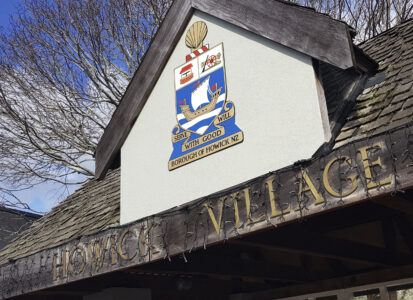
The Howick Borough Council Coat of Arms was designed by Hilda Wiseman and was presented to the Howick Borough Council in October 1953, a year after the Council was established.
The Howick Progressive Association, later called the Howick Residents and Ratepayers Association Inc, offered and advertised a New Zealand-wide competition with a prize of thirty pounds ($60). Miss EM Nixon had suggested that Howick should have a coat of arms when it became a Borough Council in 1952. She entered the competition but was not successful.
The judges were the director of Auckland Art Gallery, the representative from the New Zealand Heraldic Authority, the mayor of Howick Borough and a representative from the Howick Progressive Association.
One of the advertised rules was “that the judge’s decision was final”. Miss Nixon and another Howick resident objected strongly and made repeated complaints to Council.
Miss Nixon wanted a realistic representation of the sailing ship “Minerva”, not a Phoenician vessel as an image of the immigrant ship. The images were similar to heraldic designs.
Finally, in 1955, after long arguments, Hilda Wiseman’s design was accepted. The Borough Council made enquiries at the College of Heraldry Arms in London, England, but the fees were considered an unnecessary expense for Howick ratepayers, so it was not formally approved.
The Howick Borough Coat of Arms includes a scallop shell, the emblem of Saint James, the badge of pilgrims or immigrants from another country.
All New Zealanders are immigrants or have forebear immigrants.
The image of a well represents the early settlers who had a well for their cottages as well as one for cattle or horses. The artillery cannon represents the military settlement of Howick.
Howick Fencible pensioner-soldier-settlers never had cannons and the stockade saw no action and was an unnecessary political activity.
The majority of Fencibles came from Ireland, escaping during the Irish Potato Famine.
They were pensioners who had served for about 20 years in the British Army in India, China, Afghanistan and other countries. The “Greek sailing ship” represents the “Minerva” and other Fencible ships that brought the immigrants from Britain between 1847 to 1852.
The motto to “Serve with Goodwill” is based on the motto of the Third Earl Grey, formerly Lord Howick, Secretary of State and Colonies in the British Parliament. He was responsible for sending army pensioner Fencibles to Auckland. Howick is named after him.
Many older Howick residents remember the Howick District High School mantra “Service Before Self” above the main entrance to the school offices. This was ingrained into our minds with excellent results. Most local schools now have their own mantras and coats of arms.
Miss Nixon was a generous benefactor for many Howick facilities and her museum and research into the Māori and European settlement enhanced our understanding of our history. She donated her property and buildings to the people of Howick when she died in 1962.
The Howick Coat of Arms symbolises part of the history of Howick and is recognised with considerable pride on the Picton Street Bus shelter, on Howick Local Board letterheaded notices, at the Howick Information Centre, Howick Residents and Ratepayers Association notices and on many sports clubs’ uniforms and especially on our Howick Town Crier’s costume.
- Alan La Roche MBE
Howick Historian
alanlaroche@xtra.co.nz











